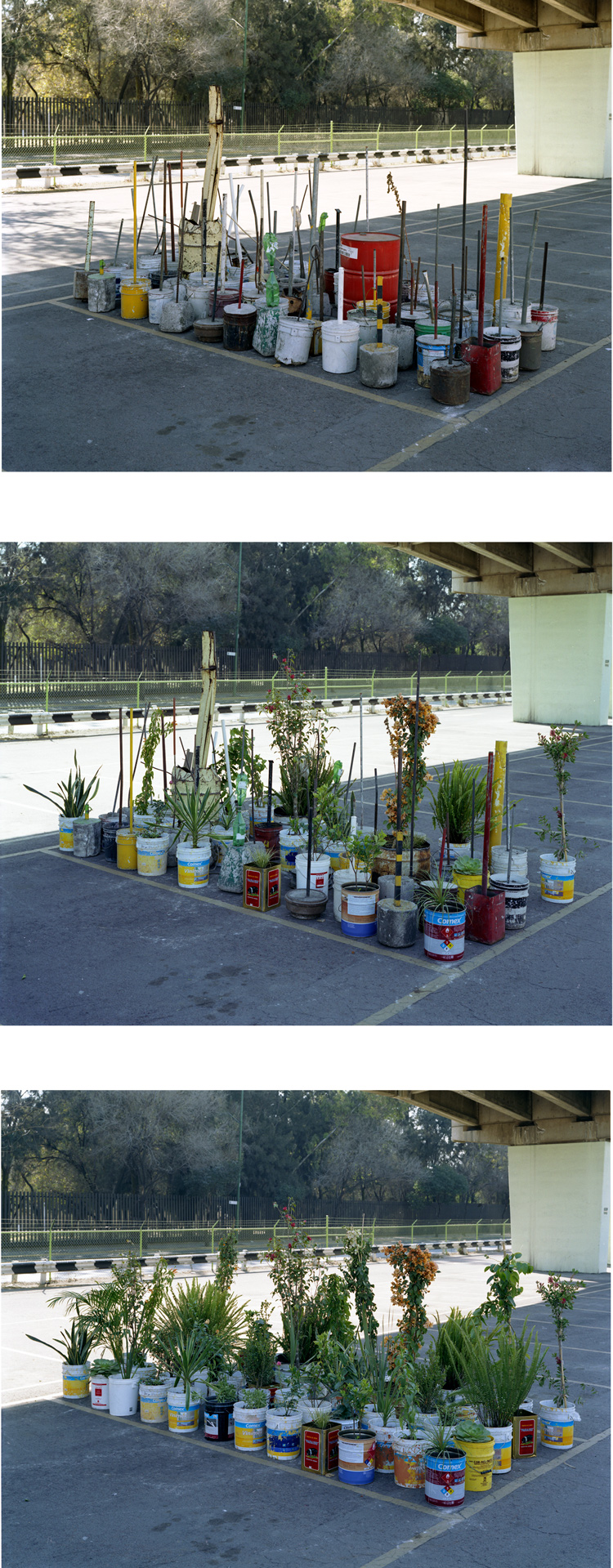Esquemas para una oda tropical, 2005, tecnica mixta con plantas y juego de 3 fotografías 38 x 41 cm c/u.

Para aquellos de nosotros que creemos, incluso hoy en día, que nuestro trabajo puede proponer o proyectar una mejor realidad, lo inmediato nos sirve no sólo de perfecto campo de prueba y experimentación sino de motivación y ejercicio necesario. No hay nada más terrible que el vacío de no permitirse haberlo intentado.
Esquemas para una oda tropical es una colección de estorbos robados y apropiados de las calles de las calles de la Ciudad de México a lo largo de varios años y unas réplicas de éstos elaborados con plantas.
Desde el humor y la ironía, los estorbos crean en su conjunto una lectura de la situación cotidiana que lleva a los automovilistas a la desesperción, como resultado de la frustración por no poder encontrar un pequeño fragmento de la ciudad para estacionar sus aotomóviles.
La existencia de estos singulares armatostes, realizados con los materiales más diversos y precarios que se encuantran a al mano –cubetas rellanas de cemento, hierro, madera- ponen en manifiesto no sólo el terrible y complejo problema que vive la ciudad en su funcionalidad en cuanto a la falta de un efectivo y suficiente sistema de transporte público -se dice que más de 2 millones de autos atraviesan las calles de la Ciudad de México diariamente-, sino que evidencia también el enorme poder creativo de la población y su capacidad para resolver problemasn. Esta colección que si bien remite a ciertos problemas cívicos importantes, es en cierto modo también, una suerte de homenaje a estos escultores-constructores anónimos. Ciudadanos activos decididos a tomar partido en la solución de una problemática particular, incluso si lo que crean es solo un paliativo.
La ciudad es un proceso interminable. Un organismo vivo. Este trabajo no es en absoluto alegórico, sino un ejercicio qu eapunta a una serie de conflictos urbanos fundamentals. Es un intent por descifrar una simbología citadina, y al mismo tiempo una solución radical a la deshumanización urbana.
El titulo de la pieza viene -lo he robado también- del de un poema del poeta tabasqueño Carlos Pellicer.
***
Notes For A Tropical Ode
For those of us who believe, even now, that our works may propose or project a more ideal reality, that they can improve upon our immediate surroundings, that our environment may serve not only as a perfect ground for testing our ideas and for experimentation, but also as the first stage of a project for reaching such changes. Nothing is worse than allowing oneself the terrible emptiness of never having attempted to do so.
Notes for a tropical ode is a collection of "hindrances" stolen or otherwise appropriated from the streets of Mexico City, gathered during the course of several years, in addition to a number of replicas of the hindrances that are composed of plants. This group of hindrances is a humorous reading of a situation that brings motorists to the brink of desperation each day, resulting from the frustration of being unable to find for themselves a small fragment of the city in which to park their cars.
The existence of these unique artifacts, made from whatever unthinkable array of miscellaneous and unsuitable materials happened to be at hand (especially concrete-filled paint buckets, assorted steel fragments, pieces of wood or large rocks) and assembled into bizarre shapes, makes plain not only the complexity of the problem that the city suffers insofar as the lack of an effective public transportation system-more than 2 million automobiles course through the streets of the metropolitan area every day-but it also makes patent the enormous creative power and the capacity for problem-solving of the persons that manufacture them. Some of them are, in fact, superb sculptures in their own right. This collection addresses important problems of life in Mexico City, but at the same time, it is an homage to these anonymous maker-sculptors: individuals that act decisively upon the need to solve a very specific problem, even if what they have created can be seen as only a stopgap.
A city is a never-ending process, akin to a living organism. This work is by no means allegorical: it is an exercise that points to a series of fundamental urban conflicts; an attempt to unlock an urban symbology and, at the same time, a radical solution to urban dehumanization: an invitation to provoke a deeply-seated change in the psyche and the functionality of the city itself.
This work has been divided formally into three parts, with the intention of showing a subtle and progressive change from the chronic sterility of concrete in the urban setting to the amorous and green tropical city. How much more beautiful Mexico City could be, if each of these concrete and metal artifacts and hindrances that fill its streets were to suddenly sprout ferns, orchids or vines...
The title of this work comes from-another appropriation-that of a poem by the poet Carlos Pellicer, from the Mexican state of Tabasco.
Diego Pérez